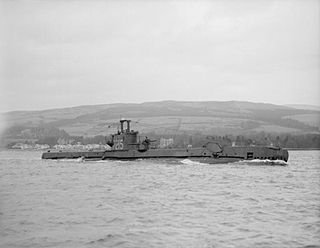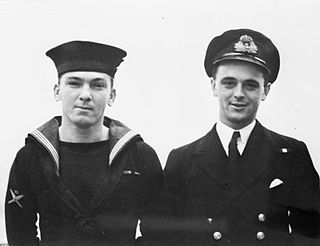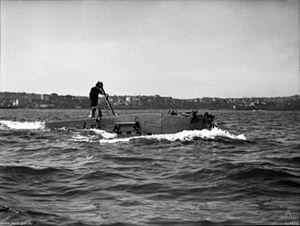
A diver propulsion vehicle (DPV), also known as an underwater propulsion vehicle, sea scooter, underwater scooter, or swimmer delivery vehicle (SDV) by armed forces, is an item of diving equipment used by scuba divers to increase range underwater. Range is restricted by the amount of breathing gas that can be carried, the rate at which that breathing gas is consumed, and the battery power of the DPV. Time limits imposed on the diver by decompression requirements may also limit safe range in practice. DPVs have recreational, scientific and military applications.

A midget submarine is any submarine under 150 tons, typically operated by a crew of one or two but sometimes up to six or nine, with little or no on-board living accommodation. They normally work with mother ships, from which they are launched and recovered and which provide living accommodation for the crew and support staff.

HMS Sceptre (P215) was a third-batch S-class submarine built for the Royal Navy during World War II. Completed in April 1943, she spent the majority of her career in the North Sea, off Norway. After an uneventful patrol, the submarine participated in Operation Source, an attack on German battleships in Norway using small midget submarines to penetrate their anchorages and place explosive charges. However, the midget submarine that she was assigned to tow experienced technical difficulties and the mission was aborted. During her next four patrols, Sceptre attacked several ships, but only succeeded in severely damaging one. She was then ordered to tow the submarine X24, which was to attack a floating dry dock in Bergen. The operation, codenamed Guidance, encountered difficulties with the attacking submarine's charts, and the explosives were laid on a merchant ship close to the dock instead. The dock was damaged and the ship sunk, and X24 was towed back to England. Sceptre then conducted a patrol in the Bay of Biscay, sinking two German merchant ships, before being reassigned to tow X24 to Bergen again. The operation was a success, and the dry dock was sunk.

Ian Edward Fraser, was an English diving pioneer, sailor and recipient of the Victoria Cross, the highest award for gallantry in the face of the enemy that can be awarded to British and Commonwealth forces. Fraser was born in Ealing in Middlesex and went to school in High Wycombe. After initially working on merchant ships and serving in the Royal Naval Reserve, he joined the Royal Navy at the start of the Second World War. After being awarded the Distinguished Service Cross for actions while serving on submarines, he was placed in command of a midget submarine during an attack in Singapore codenamed Operation Struggle. For his bravery in navigating the mined waters, and successfully placing mines on a Japanese cruiser, Fraser was awarded the Victoria Cross.

Myōkō (妙高) was the lead ship of the four-member Myōkō class of heavy cruisers of the Imperial Japanese Navy (IJN), which were active in World War II. She was named after Mount Myōkō in Niigata Prefecture. The other ships of the class were Nachi, Ashigara, and Haguro.

Human torpedoes or manned torpedoes are a type of diver propulsion vehicle on which the diver rides, generally in a seated position behind a fairing. They were used as secret naval weapons in World War II. The basic concept is still in use.

The X class was a World War II midget submarine class built for the Royal Navy during 1943–44. It was substantially larger than the original Chariot manned torpedo.

James Joseph Magennis, VC was a Belfast-born sailor and recipient of the Victoria Cross, the highest award for gallantry in the face of the enemy that can be awarded to British and Commonwealth forces. He was the only native of Northern Ireland to receive the Victoria Cross in the Second World War.

Takao (高雄) was the lead vessel in the Takao-class heavy cruisers, active in World War II with the Imperial Japanese Navy. These were the largest cruisers in the Japanese fleet, and were intended to form the backbone of a multipurpose long-range strike force. Her sister ships were Atago, Maya and Chōkai. Takao was the only ship of her class to survive the war. She was surrendered to British forces at Singapore in September 1945, then sunk as a target ship in 1946.

Britain's commando frogman force is now the Special Boat Service (SBS), whose members are drawn largely from the Royal Marines. They perform various operations on land as well as in the water. Until the late 1990s, all members of the Special Air Service (SAS) Boat Troop were trained as commando frogmen.

Operation Source was a series of attacks to neutralise the heavy German warships – Tirpitz, Scharnhorst and Lützow – based in northern Norway, using X-class midget submarines.

Biber was a German midget submarine of the Second World War. Armed with two externally mounted 53-centimetre (21 in) torpedoes or mines, they were intended to attack coastal shipping. They were among the smallest submarines in the Kriegsmarine.

HMS Stygian was a S-class submarine of the British Royal Navy, and the only ship so far to bear the name. The boat is listed as being a member of the fourth group, although she had the external stern torpedo tube fitted as in the third group.

Above Us the Waves is a 1955 British war film about human torpedo and midget submarine attacks in Norwegian fjords against the German battleship Tirpitz. Directed by Ralph Thomas, it is based on two true-life attacks by British commando frogmen, first using Chariot manned torpedoes in Operation Title in 1942, and then X-Craft midget submarines in Operation Source in 1943. Filmed at Pinewood Studios, England, with outdoor scenes in Guernsey, some of the original war equipment was used in the film.

HMS Sea Nymph was a S-class submarine of the third batch built for the Royal Navy during World War II. Completed in July 1942, she spent the majority of her career patrolling the waters off Norway in the North Sea, then was sent to the Pacific but was forced back due to technical problems.

HMS Spark was a S-class submarine of the third batch built for the Royal Navy during World War II. She survived the war and was scrapped in 1950.

HMS Bonaventure was a submarine depot ship of the Royal Navy. She was initially built for civilian service with the Clan Line, but on the outbreak of the Second World War she was requisitioned by the Navy and after being launched, was converted for military service.
Lieutenant Commander John Elliott Smart was an officer in the Royal Navy, who commanded one of the midget submarines that attacked the German cruiser Lützow and the Japanese cruiser Takao during the Second World War.
William James Lanyon Smith was a New Zealand naval officer. He served in the Royal New Zealand Naval Volunteer Reserve during World War II and was second-in-command of a midget submarine during an attack in Singapore codenamed Operation Struggle, for which he was appointed a Companion of the Distinguished Service Order.
Operation Sabre was a Royal Navy military operation in World War II. It involved cutting the Japanese submarine communications cable linking Saigon and Singapore. operating from an X-Craft midget submarine in the Saigon River delta on 31 July 1945.



















